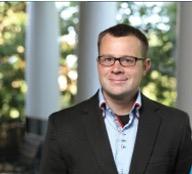Event
Physical Chemistry Seminar: Dr. Christopher Paolucci, University of Virginia
"Using Computational Modeling to Address Challenges in the Dynamics and Stability of Catalysts"

Abstract
My research group uses molecular simulations and mathematical modeling to understand the fundamentals of catalyst stability. These include catalyst synthesis, dynamic changes in surface structure under reaction conditions, and deactivation. In this seminar I discuss two relevant examples from our research group: the dynamic evolution of Ag surfaces during ethylene epoxidation, and catalyst deactivation and regeneration by the interconversion between Pd cations and nanoparticles supported on zeolites.
Silver nanoparticles (NPs) are commercial catalysts used for selective oxidation of ethylene to ethylene oxide (EO). Upon exposure to ethylene and O2, or O2 alone, numerous studies indicate that the Ag surface reconstructs, however, the surface structures formed remain debated. Atomistic modeling of surface reconstructions with density functional theory (DFT) is challenging due to spatial and temporal limitations associated with electronic structure calculations. Here, we use DFT sampling of potential energy surfaces implemented in the Fast Learning of Atomistic Rare Events (FLARE) code to generate a Gaussian Process (GP) interatomic potential descriptive of O-Ag interactions. Enabled by the GP potential, molecular dynamics and Monte Carlo simulations show that partially oxidized Ag surfaces promote the formation of peroxide surface intermediates that are surprisingly more selective to ethylene oxide than their monatomic counterparts. Consequently, gas conditions that either completely reduce or over-oxidize Ag surfaces lead to catalyst deactivation.
Next, we apply similar computational machinery to Pd cations and nanoparticles supported on zeolites, which are used as catalysts for a wide range of chemical reactions, with various and distinct active site requirements. Therefore, sintering and redispersion processes that interconvert cations and nanoparticles underpin activation and deactivation of these catalysts, yet the influence of the nanoparticle size distribution, gas conditions, zeolite topology, and cation identity on the thermodynamic and kinetic factors influencing such interconversions are not well-understood. We use a combination of computational analyses and experimental validation to determine the conditions that generate a favorable thermodynamic driving force for agglomeration or redispersion and use kinetic Monte Carlo simulations to estimate interconversion rates. We show that water, a ubiquitous molecule in practical applications of these materials, promotes agglomeration of cations into nanoparticles, even under high-temperature oxidizing conditions.
Research
-The Paolucci group focuses on computer simulations of chemical reactions at interfaces. Research areas include computational catalysis (understanding how current catalysts accelerate chemical reactions at the molecular level, and predicting the performance of potential new ones), and modeling of material synthesis and deactivation for both catalysts and other solid materials. The group uses existing quantum and classical simulation methods and also develops new hybrid methods that bridge micro and macroscopic length scales through the use of techniques such as machine learning and Monte Carlo simulation. In addition, we work closely with experimental colleagues to validate models and test predictions.
https://engineering.virginia.edu/faculty/chris-paolucci
Host: Prof. Andrew M. Rappe
